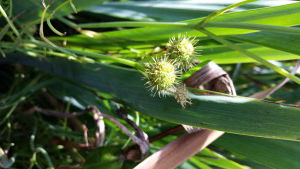The Last Stand? Re-discovering Tubular Water-dropwort – PondNet
21st September 2015
People, Ponds & Water Officer Pete Case describes how PondNet surveys have led to the re-discovery of a rare plant in the West Midlands
It’s a Friday morning in early September and I’m in a suburb of the Black Country not far from Wolverhampton, on the hunt for a rare wetland plant. It’s perhaps not the first place you’d think to look, but this landscape was very different just thirty years ago. Looking back over historic maps, the area I’m standing in would have had around twenty ponds all within a few hundred yards. Today, after decades of regeneration and development, there are just two ponds left.

I’m with PondNet volunteer Yoke van der Meer, a keen amateur botanist from Birmingham, who is helping Freshwater Habitats Trust to follow up historic records of Tubular Water-dropwort Oenanthe fistulosa, which was last recorded in Birmingham and the Black Country over fifteen years ago. Part of PondNet, our national volunteer-led survey of ponds, is to monitor rare and declining pond species across England and Wales to track how their distribution is changing. We are recruiting and training volunteers and asking them to revisit sites with historic records to carry out surveys. This work is being supported by Local Environmental Records Centres (LERCs), in this case Ecorecord who are based at Birmingham & Black Country Wildlife Trust. Ecorecord have provided species records and helped to advertise survey opportunities to the biological recording community.
This morning we are following up the most recent records of O. fistulosa from two ponds that would once have been on the site of a large brickworks. Both ponds were well known to local botanists for their Tubular Water-dropwort populations, with numerous historic records made. Recent searches hadn’t found the plant and it was now suspected extinct in Birmingham and Black Country.

Our first pond is now located within an electricity substation compound, out of bounds to the general public. Western Power Distribution who now own the site have granted us special permission to survey, located amongst woodland and dense scrub in a no man’s land. Mark Toney from Western Power tells us that this fenced-off area is rich in wildlife; workers regularly see foxes, badgers and newts. The wooded area certainly looks like excellent terrestrial amphibian habitat with piles of bricks and debris all over the place. Presumably from the demolition of the brickworks, these refuges now provide perfect habitat for overwintering amphibians.
After hacking our way through scrub we eventually come to the site of the pond. Even from a distance things look bad. The entire basin is covered in a dense stand of bulrush – this can be a tell-tale warning sign of a pond that’s in trouble. As we get closer we realise that years of organic matter building up have resulted in the pond silting almost completely. After a good search we conclude there is no chance tubular water-dropwort could survive here, it’s too overgrown and too dry for such a delicate little plant.

A little disappointed, we make our way to the second pond which is now on public open space, part of a housing estate built in the 1980’s. Sadly this pond has been stocked with coarse fish and is vulnerable to pollution, just meters away from the road. The margins are densely fringed with flag iris and bulrush, the water is turbid and murky. This is not ideal. Yoke and I start to look amongst the dense stands of emergent vegetation and almost instantly we see around forty stems of Tubular Water-dropwort. It’s a tiny population, desperately clinging on in far less than ideal conditions but it’s there and this could be the last population left in the county.
Tubular Water-dropwort has seen a catastrophic decline in recent decades across much of England and Wales. The causes for this decline are attributed to a lack of traditional management like grazing, and increasingly poor water quality in ponds which allows more vigorous plants to take hold and out-compete more delicate species. The PondNet project will continue to monitor this pond and many others for rare species.
To help with PondNet surveys please contact the People, Ponds & Water team on peoplepondswater@freshwaterhabitats.org.uk.
PondNet is part of People, Ponds & Water, a Lottery-funded project helping people make a significant difference to protecting our freshwater wildlife.
